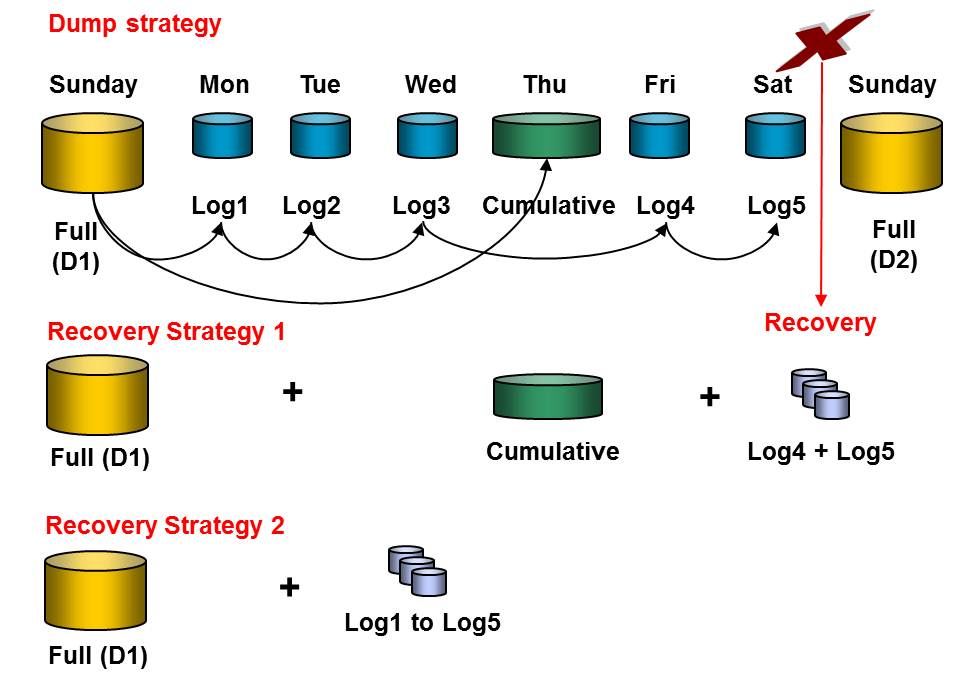You can perform cumulative dumps instead of transaction log dumps between full database dumps.
In versions earlier than Adaptive Server version 15.7 SP100, a dump sequence typically consisted of a database dump with one or more transaction logs, with the database dump and all transaction logs loaded at the same time, such as in this scenario, where a full database dump is performed once a week:

- Sunday – full database dump
- Monday – transaction log dump
- Tuesday – transaction log dump
- Wednesday – transaction log dump
- Thursday – transaction log dump
- Friday – transaction log dump
- Saturday – transaction log dump
- Sunday – full database dump
Using the cumulative dump feature, you can now perform transaction log dumps with cumulative dumps, such as:

For example, you can perform a full database dump once a week on Sundays, with cumulative dumps during the week:
- Sunday – full database dump
- Monday – cumulative dump
- Tuesday – cumulative dump
- Wednesday – cumulative dump
- Thursday – cumulative dump
- Friday – cumulative dump
- Saturday – cumulative dump
- Sunday – full database dump
When you perform cumulative dumps, you need only load the most recent cumulative dump on top of its corresponding database dump.
However, you may not always want to perform only cumulative dumps between full database dumps. Consider these issues:
- The dump size grows, because every cumulative dump taken includes the previous one.
- If any database data devices fail, you cannot recover up to the latest point in time using transaction logs.
- If the log contains large operations such as index creation, the size of cumulative
dumps can be significantly larger than the equivalent transaction log.Note: It is not always necessary to perform a dump transaction rather than a cumulative database dump. This is because while a transaction log dump will likely be smaller, it may take significantly longer to load than if you were to load a cumulative dump after the same operation.
You can use a mixed approach that combines transaction log dumps with cumulative dumps, such as:

- Sunday – full database dump to D1
- Monday – transaction log dump to Log1
- Tuesday – transaction log dump to Log2
- Wednesday – transaction log dump to Log3
- Thursday – cumulative dump
- Friday – transaction log dump to Log4
- Saturday – transaction log dump to Log5
- Sunday – full database dump to D2
If you need to perform a recovery after you obtain Log5 on Saturday, but before you can perform a new full database dump on the following Sunday, using this mixed method allows you to use one of these strategies:
- The first Sunday's full database dump to D1, with Thursday's cumulative dump and Friday's Log4 and Saturday's Log5, or,
- The first Sunday's full database dump to D1, with the five transaction logs (and not using Thursday's cumulative dump).
dump database D1 dump tran T1 dump tran T2 dump cumulative C1 dump tran T3 dump tran T4 dump cumulative C2 dump database D2 dump tran T5 dump cumulative C3
| D1 | T1 | T2 | C1 | T3 | T4 | C2 | D2 | T5 | C3 | |
|---|---|---|---|---|---|---|---|---|---|---|
| D1 | Y | Y | Y | Y | Y | Y | Y | Y | Y | Y |
| T1 | Y | |||||||||
| T2 | Y | |||||||||
| C1 | Y | Y | Y | |||||||
| T3 | Y | Y | ||||||||
| T4 | Y | |||||||||
| C2 | Y | Y | Y | Y | Y | Y | ||||
| D2 | Y | Y | Y | Y | Y | Y | Y | Y | Y | Y |
| T5 | Y | Y | Y | |||||||
| C3 | Y | Y |
This table does not show the minimal load sequence required. For example, the quickest way to get to a point in time that is the same as the second cumulative dump (C2) is to load D1 and C2, rather than D1, T1, T2, T3, T4, and C2.